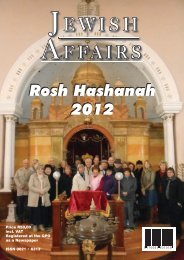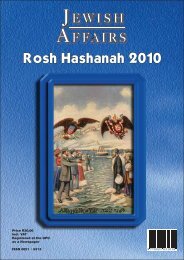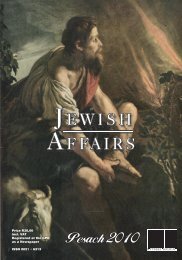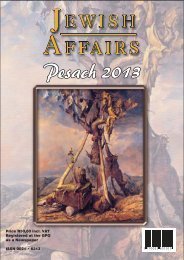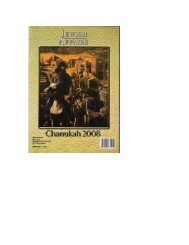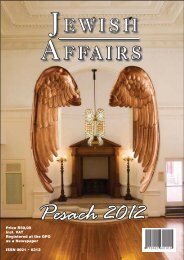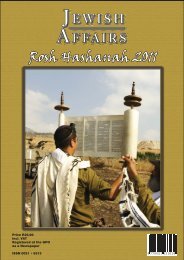Rosh Hashanah 2009 - South African Jewish Board of Deputies
Rosh Hashanah 2009 - South African Jewish Board of Deputies
Rosh Hashanah 2009 - South African Jewish Board of Deputies
- No tags were found...
You also want an ePaper? Increase the reach of your titles
YUMPU automatically turns print PDFs into web optimized ePapers that Google loves.
JEWISH AFFAIRS ROSH HASHANAH <strong>2009</strong>children <strong>of</strong> separated parents was that this would bean inducement for them to remain separated. 22Another determining factor was a means test. If aparent had the means to support the child, it wasunlikely to be accepted. 23 In all cases, parents wererequired to contribute towards the child’s upkeepaccording to their means. Grandparents and auntsand uncles were also exhorted to contribute.It is interesting that there were no applications forthe admission <strong>of</strong> children from unwed <strong>Jewish</strong> mothersduring this period. However a newborn male baby,found abandoned in a basket at the Home in April1933, could have been the exception to this rule. Thisanonymous child was unanimously declared to be<strong>Jewish</strong>, circumcised and given the name <strong>of</strong>‘Abraham’, the first Jew in the Bible. (‘TheodorHerzl’, the first name suggested, was ultimatelyrejected). The baby was then put up for adoption bya <strong>Jewish</strong> couple. 24It was initially resolved that no more than twochildren from a single family should be admitted.This criterion was put to the test in the case <strong>of</strong> thevery first application received in December 1911,when only two <strong>of</strong> the four applicants were admitted, 25but was subsequently abandoned. 26 The home alsoinitially refused to accept children who were underfive years <strong>of</strong> age, 27 but this criterion too fell away. 28It was not until 1928, however, that the first set <strong>of</strong>infants were admitted - aged three and a half, two anda half, and six months - and a Nursery Departmentestablished. 29 Besides a minimum age, a maximumage was also determined, fourteen years for boys andfifteen for girls. 30 This could be extended if the boyor girl had not yet passed Standard Seven. 31 InJanuary 1925, the maximum age was increased tosixteen.Admissions were on the whole restricted to theCape Province. Children from elsewhere, such as theOrange Free State or Durban were refused, 32 althoughchildren from Bulawayo and from Elizabethville inthe Belgian Congo were accepted. 33 On the otherhand, three children from Beira in Mozambiquewere advised to apply to the SA <strong>Jewish</strong> Orphanage inJohannesburg. 34 Children who were physicallydisabled or retarded were also excluded and theirfamilies were referred to the community charities. 35Very early on, it was laid down that the home was forpoor and destitute orphans who were physicallyhealthy. 36The circumstances <strong>of</strong> the applications reflect theexigencies <strong>of</strong> the time. A particularly poignant casewas that <strong>of</strong> a woman who had arrived from Russiaonly seven months before to join her husband, whowas acting as a shoykhet in Sutherland, WesternCape. When he suddenly passed away, she wasforced to apply to the Orphanage to admit her twosons aged six and seven. 37 In another instance, a tenyear old boy whose mother had died in Vilna wasplaced in the orphanage by his father, who wasworking as an ice cream vendor and could not lookafter him. 38 Similarly another six year old, who hadbeen deserted by his mother in Russia, was admittedbecause his father was working as a bus conductor. 39The Ukrainian pogrom orphansThe number <strong>of</strong> orphans at the home was doubledwith the arrival <strong>of</strong> the Ukrainian pogrom orphans.The first mention <strong>of</strong> them appears in the minutes <strong>of</strong>8 August 1920, when Isaac Ochberg, by then President<strong>of</strong> the Orphanage, reported that due to the war andpogroms, there were about 300 000 <strong>Jewish</strong> orphansin the Ukraine and stated that it was imperative thatsome <strong>of</strong> these be brought out to <strong>South</strong> Africa. By thetime that he approached the Committee, Ochberghad already made contact with Dr Jochelson <strong>of</strong> theFederation <strong>of</strong> Ukrainian Jews, who was willing tobring the orphans to London, and had obtained thepermission <strong>of</strong> the Minister <strong>of</strong> the Interior, PatrickDuncan, to bring them into the country. Ochberginitially envisaged bringing some 50-100 orphans ata time. He saw the Orphanage as acting as a clearinghouse, putting the children up for adoption andkeeping the remainder at the Orphanage. Lookingback, it was an amazingly romantic and heroic schemeand one that reflects the character <strong>of</strong> its originator.Isaac Ochberg, himself an immigrant from theUkraine, had become a very wealthy man in <strong>South</strong>Africa. He was totally committed and involved withthe Orphanage, on one occasion describing it asbeing his “whole life”.It was suggested that £10 000 should be raised bythe Cape Relief Fund and that a public appeal shouldbe published in the press to adopt the orphans. TheSA <strong>Jewish</strong> Orphanage was also approached to cooperate.The Committee sent out appeals for funds aswell as to ascertain how many orphans would beadopted, so as to determine how many children tobring in the first batch. 40 The public was asked tosubscribe £25 000 towards the scheme and it wasdecided that Ochberg himself should travel to theUkraine to fetch the children. 41 By January 1921,fundraising tours to the country districts had raisedover 15000. The Johannesburg Committee had in themeanwhile succeeded in convincing General Smutsto agree to contribute towards the fund on a pound forpound basis. 42 Immediately on Ochberg’s return inSeptember, the campaign to raise £25 000 was set inmotion. 43Ochberg originally collected 233 orphans andbrought them to the Temporary Shelter in Warsaw,but 37 ran away while others took ill so that it wasimpossible to take them to London. He finallydeparted for <strong>South</strong> Africa with 167 on the EdinburghCastle, on which special accommodation for theorphans had been arranged. Various welcomingreceptions were arranged in Cape Town including aMemorial and Thanksgiving Service in thesynagogue. 44 It had been agreed that the children bedivided equally between Johannesburg and CapeTown, with seventy ultimately being sent to theformer while the balance was accommodated at theCape <strong>Jewish</strong> Orphanage. 45 Ochberg also broughtalong a Mr. and Mrs. Maman to act as the newprincipal and matron respectively, a Mrs. Zalkow tobe an assistant doctor and a Miss Bettman to teachHebrew. Fortunately, the incumbent matron had22



